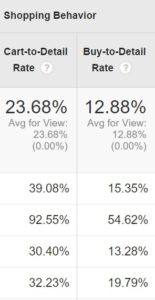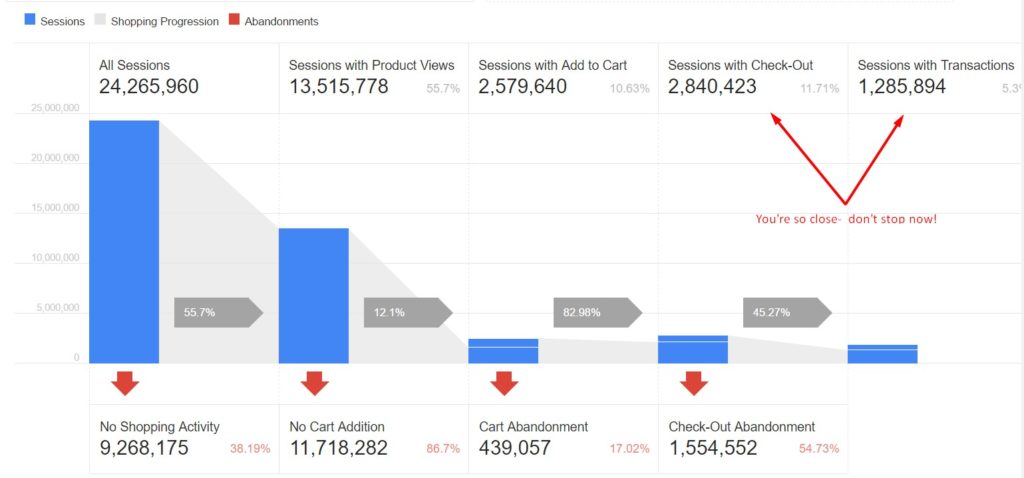The Lesser Used Metrics of Ecommerce
We all know the metric rockstars of eCommerce reporting – transactions, revenue, average order value, etc. This post isn’t about those metrics – they already get enough press. This is about the unsung, and too-often ignored, metrics of eCommerce. These are the details that are not as glamorous but can be even more influential to creating incremental sales and revenue. (For general details about eCommerce tracking and its implementation, I highly recommend you take a look at LunaMetrics and some of their posts. To get you started: Google Analytics Enhanced Ecommerce: The Order of Implementation)
Product Views – Cart Adds – Cart Removals
Great, our product is selling. In the last month, we sold 5 widgets for $500 in revenue. (These are top class widgets.) How many were viewed but never added to the cart? How many were added to a cart, but removed before checkout? What was the view to purchase rate?
Once we have these figures we can begin delving into the ‘why’ and ‘how so’. This is often a good time to collaborate with members of your promotions/marketing and UX teams.
Pricing: Is there a pricing issue, as in the price point is above the comfort level of many visitors. Can a coupon code help increase conversions?
Coupons: Are visitors leaving the site to look for coupon codes and failing to return in a timely manner?
General Savviness: Are many of the visitors adding products to their carts, and not checking out, returning visitors? Have they received retargeting ads previously (which typically includes some variation of “Come back – we’ll give you a discount…”
Mobile: Is the mobile experience keeping pace with the audience? Is it user-friendly and responsive? All too often we experience sites which on the surface are great via mobile, but once in the shopping portion of the experience, it gets buggy, or even flips us over to the desktop version. Ugh.
Site Searches
Know exactly how to navigate to your favorite products on a website? Excellent! Could a new visitor to your site find the same product just as easily? Or what if the next time you came to that site you find the whole thing had been redesigned?
Some of you reading this might not work with a site using on-site search, but don’t be too quick to breathe a sigh of relief. Site search is like a mini user experience test. What pages did users look at before conducting their search? Were users who looked at a particular product or product line more likely to search? This report can be extremely insightful in piecing together why some conversions may not have happened.
Think about how the search terms in the report are represented in the SEO strategies – are they appropriately represented in the site’s content? Could some of these perhaps be target keywords or topics for link building? Do we just need to try updating our paid search ad copy to include a specific keyword? In one client’s case (of which I’ve personally worked on), it led to producing a product in a new color variation. Sales initially spiked for the product for a brief time while we promoted the launch of a new color. Since then, sales have steadied and account for a 2% incremental increase – enough to cover the additional materials and manufacturing costs of a new color.
Segments
Ok, not an actual metric itself, but absolutely necessary. We are all unique snowflakes (not really, but I was stuck on a creative metaphor). Our customers are all different but can be categorized. How does device type influence transactions? Gender influence? What about the day of the week?
The key to understanding your buyers is to also look at the differences between them. If a particular group is converting more so than another, what is it about that group which is so different than the others.
An obvious, but still necessary example of looking at segments differently.
Let’s not forget about (outside) data. We’re also big advocates for looking at the big picture of data outside our analytics platforms. Are there contributing review authors that, when they post, tend to drive increased transactions? Do your refunds come from a particular marketing channel or product line?
Remember, while completed transactions are great (and really, the point many of us are in business). However, let’s not forget about those unsuccessful transactions and what we can learn from those. One of the ultimate successes is converting a user to a customer.










